Aviation Technology Group's Dream is Taking Shape
When we first told you of this two-place, tandem, twin-jet, we
used the word, "Incredible." That word can be taken a couple ways,
and frankly we didn't know which one we preferred. When the
full-size mockup's rollout was covered by ANN Rocky
Mountain correspondent Allan Lockheed, he told us, "These guys are
serious, and they're doing the right things." Allan's reputation in
the speed business is unquestioned, and he's also a darned good
engineer, so we were anxious to see the mockup for ourselves at
NBAA.

Dr Robert Wolf, the VP of Engineering, gave us a thorough
walk-around. Since this is a mockup, the discussion revolved around
aerodynamics and the macro-concepts of the plane.
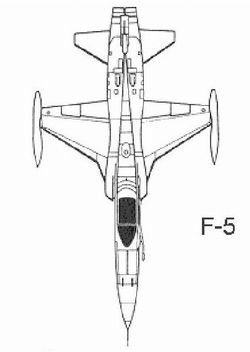 Not yet incorporated into the
mockup, but there in the company's literature, was an F-5-like
'notch' in the leading edge of the wing. Dr Wolf said that
wind-tunnel work (performed at the Kirsten wind tunnel of the
University of Washington's Aeronautical Laboratory) disclosed a
separation of airflow over the top of the wing, close to the
fuselage, at high angles of attack. Although several shapes were
tried in the tunnel, Dr Wood said, "At the end of the day --
literally -- that profile, like the one from the F-5, was the one
that worked the best." Farther out, three feet from the wingtip,
there's another change in the wing, noticeable as the leading edge
suddenly juts out maybe three inches. "We could have used a
'vortelon,'" as the DC-9's designer called it, "but this shape also
gave us some additional advantages." At that point, the
wing's chord increases, and the leading edge itself sports a larger
radius. The 'notch' there tends to keep the separated air (nearer
the fuselage, at high angles of attack) from interfering with the
airflow over the last three feet of wing -- and the aileron
directly behind it.
Not yet incorporated into the
mockup, but there in the company's literature, was an F-5-like
'notch' in the leading edge of the wing. Dr Wolf said that
wind-tunnel work (performed at the Kirsten wind tunnel of the
University of Washington's Aeronautical Laboratory) disclosed a
separation of airflow over the top of the wing, close to the
fuselage, at high angles of attack. Although several shapes were
tried in the tunnel, Dr Wood said, "At the end of the day --
literally -- that profile, like the one from the F-5, was the one
that worked the best." Farther out, three feet from the wingtip,
there's another change in the wing, noticeable as the leading edge
suddenly juts out maybe three inches. "We could have used a
'vortelon,'" as the DC-9's designer called it, "but this shape also
gave us some additional advantages." At that point, the
wing's chord increases, and the leading edge itself sports a larger
radius. The 'notch' there tends to keep the separated air (nearer
the fuselage, at high angles of attack) from interfering with the
airflow over the last three feet of wing -- and the aileron
directly behind it.
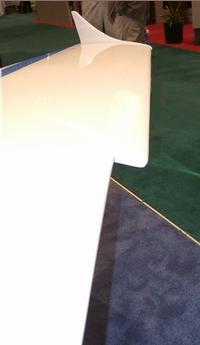 As for that aileron and the flaps
that are outlined on the mockup's surface: that's a change.
Originally, the design had a full-width flaperon, as on the F-16;
but "the inputs and effects didn't come out linear," Dr Wolf
explained. That's not a problem on the F-16, he said, "because that
machine has all those computers flying it." More wind tunnel tests
are scheduled for November; few changes are expected to emerge
after that session.
As for that aileron and the flaps
that are outlined on the mockup's surface: that's a change.
Originally, the design had a full-width flaperon, as on the F-16;
but "the inputs and effects didn't come out linear," Dr Wolf
explained. That's not a problem on the F-16, he said, "because that
machine has all those computers flying it." More wind tunnel tests
are scheduled for November; few changes are expected to emerge
after that session.
The winglets serve a couple purposes. First, there is a "small
but measurable" aerodynamic advantage; perhaps equally importantly,
the winglet affords a large-enough surface on which to mount a
wingtip light. Plus, like the dorsal ridges at the front of the
main vertical fins, they clearly don't hurt, and they look cool. As
for those ventral fins, they do add noticeably in directional
stability.
The full-flying horizontal tail is complemented by a
conventional fin/rudder combination. Well, the fin/rudder
aerodynamics are special. Obviously splayed out (as on an F/A-18),
they also don't point directly ahead.
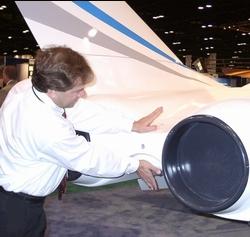 The wind tunnel showed that drag was
reduced and stability increased, if they were pointed ever so
slightly out, from the centerline of the airplane. The included
angle is about 1 degree, and you really can't see it; but Dr Wolf
assured us it was in there...
The wind tunnel showed that drag was
reduced and stability increased, if they were pointed ever so
slightly out, from the centerline of the airplane. The included
angle is about 1 degree, and you really can't see it; but Dr Wolf
assured us it was in there...
The Williams FJ-33s will give this machine the best
weight-to-thrust available in a production machine; and between
them will mount the speed brakes, which will open both up and down,
from their hinges at the extreme rear (as in the 'manual'
demonstration Dr Wolf made).
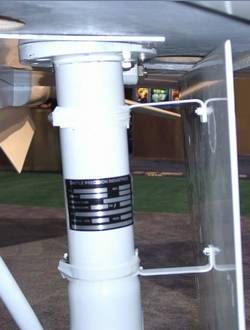 The gear is all set, being a massive
Castle Precision Industries trailing link setup with an odd tire
size -- 16 x 4.4. The wheels and brakes will be identical, or
nearly-identical, to those on the Swearingen SJ-30. There's a bit
of what looks like negative camber in the gear struts -- some 5
degrees -- but the tires themselves will sit vertically. This
arrangement is due to the very limited space, where the mechanisms
will tuck up. ('Straight' legs would hang the tires too low.) In
fact, small blisters (aerodynamically insignificant) will stretch
over the center of the wheel, allowing the full-yoke forging to be
covered in flight.
The gear is all set, being a massive
Castle Precision Industries trailing link setup with an odd tire
size -- 16 x 4.4. The wheels and brakes will be identical, or
nearly-identical, to those on the Swearingen SJ-30. There's a bit
of what looks like negative camber in the gear struts -- some 5
degrees -- but the tires themselves will sit vertically. This
arrangement is due to the very limited space, where the mechanisms
will tuck up. ('Straight' legs would hang the tires too low.) In
fact, small blisters (aerodynamically insignificant) will stretch
over the center of the wheel, allowing the full-yoke forging to be
covered in flight.
The cockpit design wasn't shown; and the luggage spec calls for
one standard-size carry-on piece of luggage, plus two generic golf
bags. As the systems come together, the final shapes, inside, will
become better-defined.
This machine, a 'fighter for the masses,' has other possible
purposes, which we covered in earlier articles: 'point-interceptor'
comes to mind. Its quick-footedness and projected low costs of
operation (Mach .92 on 78 cents a mile) look good for a number of
sport, transport, and defense applications.
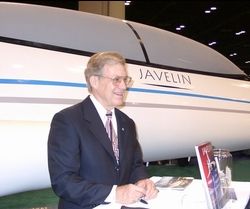 Adding credence to the
plane's potential was the last American Ace, Brigadier General
(Ret) Stephen Ritchie, who recently signed on to the Javelin team
as a consultant and spokesman. He said he thinks the company's on
the right track; and he looked right at home, standing next to the
little 'Tiger Shark.'
Adding credence to the
plane's potential was the last American Ace, Brigadier General
(Ret) Stephen Ritchie, who recently signed on to the Javelin team
as a consultant and spokesman. He said he thinks the company's on
the right track; and he looked right at home, standing next to the
little 'Tiger Shark.'
Customer deliveries are anticipated after certification in 2005.
The Javelin should go .92 Mach, top 51,000 feet, travel 1440
statute miles (with reserves), and look like nothing this side of
NATO.
We'll keep you updated on this increasingly-interesting story.
Get your $1.88 million (estimated) ready.
 Aero-FAQ: Dave Juwel's Aviation Marketing Stories -- ITBOA BNITBOB
Aero-FAQ: Dave Juwel's Aviation Marketing Stories -- ITBOA BNITBOB Airborne 05.19.25: Kolb v Tornados, Philippine Mars, Blackhawk Antler Theft
Airborne 05.19.25: Kolb v Tornados, Philippine Mars, Blackhawk Antler Theft Klyde Morris (05.19.25)
Klyde Morris (05.19.25) Airborne-NextGen 05.20.25: Drone Regs, Zero-Emission Cargo, Door-Dash Drone
Airborne-NextGen 05.20.25: Drone Regs, Zero-Emission Cargo, Door-Dash Drone Airborne Affordable Flyers 05.22.25: RV-15 Finalizing, OSH NOTAM, Kolb v Tornado
Airborne Affordable Flyers 05.22.25: RV-15 Finalizing, OSH NOTAM, Kolb v Tornado








